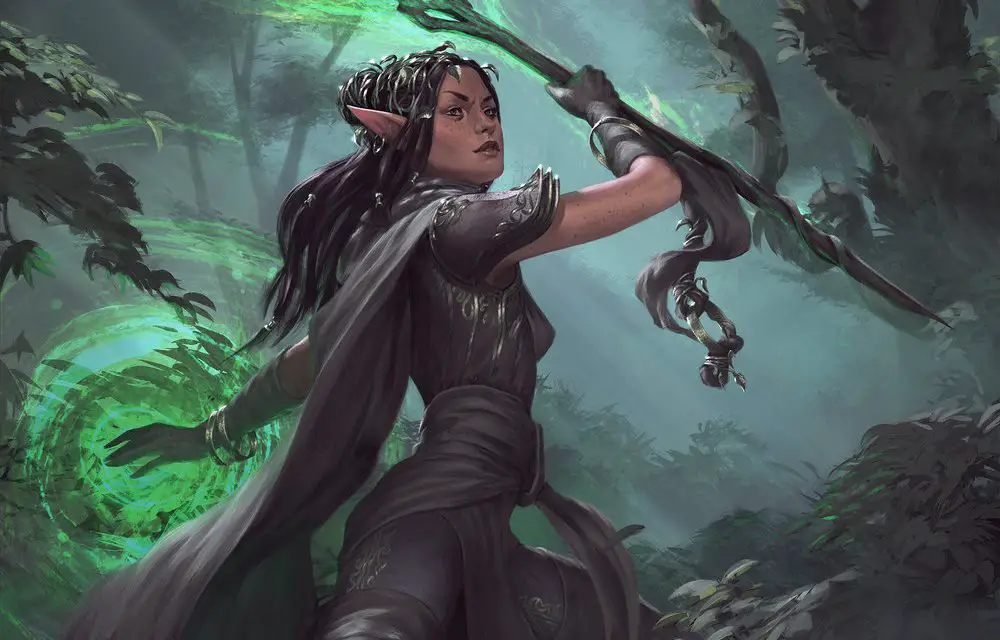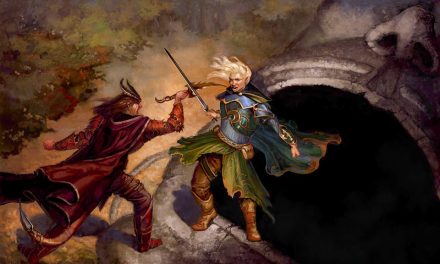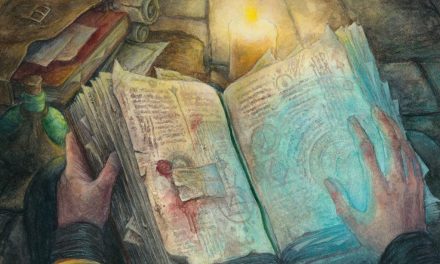As a Druid in D&D 5e, your character is almost infinitely versatile.
You’re able to cast huge AoE spells to destroy enemies, pump out healing to keep your friends in the fight, and shapeshift into a wide variety of animals.
But what about those times when you just need to give an enemy a good smack with your trusty club or quarterstaff?
Those times are going to happen, so it’s best to be prepared!
Because of that, we turn to one of the most underrated cantrips in D&D 5e: Shillelagh.
This article will explain how Shillelagh works in D&D 5e as well as give tips for using it in your own games and answering some common questions about the cantrip.
What Does Shillelagh Do?
Let’s start with how Shillelagh is listed in the Player’s Handbook.
The wood of a club or quarterstaff you are holding is imbued with nature’s power.
For the duration, you can use your spellcasting ability instead of Strength for the attack and damage rolls of melee attacks using that weapon, and the weapon’s damage die becomes a d8.
The weapon also becomes magical, if it isn’t already.
The spell ends if you cast it again or if you let go of the weapon.
- School: Transmutation
- Casting Time: One bonus Action
- Range: Touch
- Components: Verbal, Somatic, Material (mistletoe, a shamrock leaf, and a club or quarterstaff)
- Duration: One Minute
- Classes: Druid
So instead of using the normal ability modifier (Strength, in most cases), you will be using your spellcasting ability modifier. As a Druid, this would be your Wisdom modifier.
Without Shillelagh, attacking with your club or quarterstaff would look like:
Attack Roll:
1d20 + Strength Modifier + Proficiency Bonus
Damage:
1d8 + Strength Modifier
As a Druid, I’d be willing to bet that your Wisdom score is higher than your Strength score.
That’s exactly where Shillelagh comes in handy if you find yourself needing to deliver some swift bonks to your enemies’ heads in a manner that would make Rafiki from the Lion King proud.

Attacking with Shillelagh, your rolls would now look like this:
Attack Roll:
1d20 + Wisdom Modifier + Proficiency Bonus
Damage:
1d8 + Wisdom Modifier
Why Use Shillelagh in 5e? (Pros vs Cons)
There will almost certainly be situations in your game where you will need to attack with your weapon. You might be out of Wild Shape uses, don’t want to burn a big spell on a weak enemy, or are playing a Druid subclass that relies on you being up in the enemies’ faces.
Strength isn’t such a priority for most Druids, though, so being able to use your Wisdom modifier on attacks and damage is incredibly helpful.
Additionally, as a major “pro” for this humble cantrip, your weapon becomes magical for the duration. Especially at low levels when your party likely hasn’t acquired magical weapons yet, monsters that resist nonmagical damage (like ghosts or lycanthropes) can be particularly dangerous.
Because it only takes a bonus action to cast and lasts for a minute, you get 10 rounds of this buff. That should be more than enough time in most situations.
The only real downside to the Shillelagh cantrip is that it doesn’t scale at higher levels. Because you are only getting one attack action as a Druid, you’re dealing 1d8+WIS damage at most per turn.
That’s great in the early levels, but it’s not exactly something to rely on too heavily once you’re into the mid-levels.
But Shillelagh is a cantrip that has the potential to be very high-impact in the right situations. It’s not uncommon for classes that can get multiple attacks (like Monks, who are also Wisdom-based) to multiclass into Druid just for this cantrip!
Related: The Complete Guide to the Druid in D&D 5e
How and When to Use Shillelagh
Right before you take your first melee attack action in combat, you should use your bonus action to cast Shillelagh. This will improve your chance to hit as well as the amount of damage that you are putting out.
The effect should last you the entire fight.
In the past, I’ve had situations where the Druid might need to smack something particularly hard to get it to work right. In the case of a rusty lever, jammed door, or other such situation, I’ve lowered the difficulty due to the Druid’s casting of Shillelagh if it’s a situation where a particularly powerful smack might solve the problem.
Frequently Asked Questions
There are a bunch of questions around the use of Shillelagh that I want to take a moment to specifically answer.
Is Shillelagh Good in 5e?
I’ve played several Druid characters and I don’t think a single one of them didn’t have Shillelagh.
Even if you never have to use it, it’s a great “just in case” spell to have on your list. Especially if you’re playing a campaign and expect to encounter ghosts or other such nonmagical-resistant creatures at early levels, you’ll be glad you took it!
While there is one other cantrip that made our list of the best Druid spells by level, Shillelagh is a close second!
What can you cast Shillelagh on?
Per the spell’s description, Shillelagh is cast on a club or quarterstaff that you are holding. This effect lasts until you cast the spell again or let go of the weapon.
If you are trying to cast Shillelagh on a spear, that’s a bit of a stretch. The spell is meant to work with a bludgeoning weapon. I suppose you could say that you’re smacking the monsters with the spear instead of lunging at them, but that would be between you and your DM.
Does Shillelagh work with the Polearm Master feat?
Among other things, the Polearm Master feat allows you to use your Bonus Action to make a second attack with a polearm. The damage of that second attack is a d4.
If you combine Shillelagh with the Polearm Master feat, you get an interesting combo when attacking with a staff.
This discussion on RPG StackExchange is pretty thorough on how this interaction works.
Your first attack with your quarterstaff and Shillelagh would be as described above. The second attack (with the butt of the staff) would not deal the 1d8 damage from Shillelagh but would still get your Wisdom modifier on the attack roll instead of your Strength modifier.
But, as with pretty much everything in D&D, your table might be different.
In the campaign where I played as Joab (who was a Circle of Dreams Druid), I used this combo.
Talking it over with the DM, he agreed that getting a d8 damage instead of a d4 on the second attack was fine. It uses a bonus action and situations where my character needed to attack with his staff were incredibly rare as our game went on.
For players, always talk with your DM but accept however they rule on an issue.
For DMs, always look for opportunities to empower your players and let them do cool stuff.
Does Shillelagh count as a spell attack?
Attacks made with a weapon that you’ve cast Shillelagh on are effectively normal melee attacks with a magical weapon.
This is because the weapon itself is enchanted. The spell is not cast every time you are swinging the weapon.
Is Shillelagh magic damage?
Because a club or quarterstaff that you cast Shillelagh on is considered to be magical, that weapon’s damage is not resisted by creatures that would resist non-magical damage.
The weapon still does bludgeoning damage but overcomes resistance to non-magical damage.
Can you cast Shillelagh on a Magic Weapon?
Yes, you can cast Shillelagh on a magic weapon if it fits the other requirements on the spell. That is, it must be a club or quarterstaff made of wood.
Can you attack with Shillelagh as a Bonus Action?
Casting Shillelagh on your weapon takes a bonus action. From there, you would use your Action to attack as you normally would, but now you have a pumped-up staff or club to help you bring the pain.
Unlike some spells that are cast as you are attacking, Shillelagh just takes a bonus action. If you don’t have use of your bonus action in the first round of combat and aren’t attacking with your weapon this turn, you might as well cast Shillelagh just in case you end up needing it later.
Do you add Proficiency to Shillelagh?
Your proficiency bonus is added to attacks with a weapon that you have cast Shillelagh on.
As explained earlier in this article, your attack roll would be 1d20 + WIS + your proficiency bonus. The damage roll would be 1d8 + WIS.
Conclusion – Shillelagh in D&D 5e
I hope you found this guide useful!
The Shillelagh spell is a great example of low-level abilities with big impact. It absolutely deserves a place on every Druid’s list of prepared spells!
Of course, there’s also the classic question of Shillelagh vs Primal Savagery and which one Druids should take. You can check my article about this rivalry out here!
Want to stay updated with all of the latest content here from Tabletop Joab?
Join the newsletter by signing up below so you never miss a thing!









